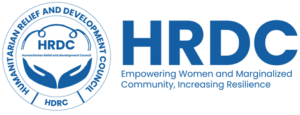HRDC will support shelter and NFI’s to affected population by:-
• Ensuring sufficient, coordinated and adequate delivery of emergency shelter solutions and shelter repair assistance to respond to the immediate shelter needs of the affected people
• Delivering transitional shelters and repair assistance to respond to the specific shelter needs of the affected people e.g. persons with disabilities
• Delivering flexible coordinated, adequate and harmonized NFI kits to the affected population
• Monitoring the delivery of coordinated, adequate and harmonized shelter and NFI kits to affected population
In addition to providing the affected population or its partners with NFIs and shelter materials, HRDC’s Shelter and NFI programs should include interventions to complement the delivery of materials with interventions that promote community engagement and resilience building.
Key components of HRDC’s settlement approach to Shelter and NFI response include Capacity Building and Shelter Construction.
Capacity Building: HRDC often seeks to work with crisis-affected populations, especially after natural disasters, to deliver shelter related training. The aim is to improve skills and knowledge to build back safer, recognizing that the primary responders and those ultimately responsible for reconstruction are crisis-affected populations.
Protection Mainstreaming and Gender Mainstreaming in Shelter and NFI Programmes
HRDC acknowledges Shelter and NFI interventions are critical to the survival of populations displaced by humanitarian emergencies. Failure to consider GBV-related risks in programming can result in increased GBV exposure for the affected community. For example, Shelters that are poorly designed (e.g. with insufficient partitions in sleeping areas; lack of privacy for dressing and bathing) may increase the risk of sexual harassment and assault for inhabitants.
Risks of GBV can be reduced by designing programs that continuously monitor for and develop strategies to address emerging GBV-related safety risks related to shelters, settlements, and NFIs. This requires meeting internationally agreed-upon standards while also taking into account social patterns from the onset of the emergency and into the recovery phase to build safer and more resilient communities in the long term. HRDC to achieve this engages men, women, girls, boys, and other at-risk groups in the design and delivery of their programming; prioritize GBV risk reduction in the allocation of shelter materials and shelter construction, and ensure equal and impartial distribution of NFIs.

